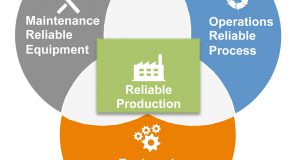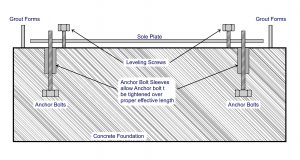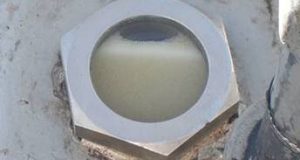Turning Maintenance Challenges into Production Opportunities
One day I was asked to go to a mill in the Southern part of the US to help improve the output of a paper machine. I asked, “How much time do we have?” The answer was “Less than a year!” I said, “OK! Let’s do it.”
The paper machine uptime performance was way below industry standards, with many unscheduled stops and quality issues. We figured out that only a six percent increase in output would be a significant improvement and yield a good profit margin. This was our target for the project.
I know you’ve seen it before: water, pulp, oil, and chemicals leaking and paper scrap on top of equipment everywhere. There were old parts lying around, mold growing, seal water gushing down onto the floor, and rust on equipment. I’m not confident that painting or detailed cleaning had been done within the last century. To be honest, I was surprised to see that anybody wanted to work there.
LET’S START WITH THE BASICS
After a very spirited meeting with the management team, we agreed to start working on the weekly planning and scheduling process.
The first step was to start planning and scheduling work orders. We decided that “all work must be documented in the work request.” Sounds simple, but it is easier to just tell the maintenance tech what needs to be done so they can generate the work request. It was especially difficult to get the process engineer to adhere to this.
The next step is to have the operations and maintenance coordinator (OMC) screen and approve the work requests with the maintenance supervisor. The hurdle here was to get operations to assign somebody the role of the OMC. Another problem surfaced: priorities were set by who was screaming the loudest, not based on business needs. So, we agreed on and documented a work order priority system. Since many work orders were delayed and not repaired in time to avoid equipment problems, every request was urgent in the mind of the requester.
Now we needed to start setting up the objectives of the weekly planning and scheduling meeting. The maintenance supervisors should come to the meeting with a prepared draft schedule. We started by scheduling the meeting for Thursday afternoon and ensuring that the schedule was updated and complete after the meeting. The schedule was then published, sent out to operations, and posted in the maintenance shops.
We immediately experienced conflict in the meeting because it was all about what to schedule, and not what the planner should plan for the next four weeks. To solve this, we split the weekly meeting in two parts:
- Tuesday afternoon—Planning priority meeting. The planners meet with the OMC to set priorities for which work orders to plan.
- Thursday meeting—Finalize next week’s schedule. The maintenance supervisors, OMC, operations supervisor, and process engineer must all agree on the schedule.
So far, so good. Now we have screened, approved, and prioritized work to be planned. There was no significant planning done except identifying critical parts on some of the work orders. There was a lot of experience among the tradespeople, but none of that knowledge was captured in procedures to improve precision maintenance practices. We created a simple job scoping template so the planner could gather all the information. The idea was to make the job scoping template consistent and save that as a standard job plan in the CMMS.
This was very successful. The planners created more than 500 job plans over the next year. In the beginning, the tradespeople received the schedule with skepticism; as the quality of the schedule improved, so did their feelings toward it.
We still had the problem of the supervisor and tradespeople not using the work order packages. This meant that things were being missed, resulting in rework. Work order packages should be a resource for tradespeople: necessary safety procedures, special tools needed, parts already kitted at the job site, and a feedback sheet for the planners to keep the work package and standard job plans up-to-date and continuously improving.
We had several meetings with the different teams, and they asked us why we needed to record time and parts used in the work orders. “You must be checking on us,” said one electrician. Of course, everybody—including me—must be held accountable for the work we do. The work order history is used to determine which equipment incurs the highest maintenance cost.
Finally, we had the buy-in, and the following questions were answered:
- What did you find wrong?
- How did you fix it?
- How much time was used, including waiting and travel time?
- Which parts were charged to the work order?
CRASHING THE WEEKLY SCHEDULING MEETING
Around six months had passed since we started the optimized planning and scheduling process on PM4. I came back to participate in the weekly scheduling meeting and check on progress. Here are actual notes I took during this meeting:
- Meeting agenda was not used.
- Several people were late to the meeting.
- The supervisor had not prepared the draft schedule.
- The process engineers kept telling the maintenance supervisor what jobs they needed—but they had not generated any work requests.
- Several people were talking over each other.
- The operations manager came in, said something about a work order, then quickly left before questions could be asked.
- The OMC had not looked at the backlog the last few days.
I had heard enough. I stood up and said, “What is going on here?” Suddenly, the room went quiet and everyone stared at me. I had raised my voice; they could tell I was disappointed. “This process is important for us to meet our productivity goals,” I explained. I could see the operations supervisor looking at me and smiling from the corner of my eye. “We agreed to use the agenda, get here on time, prepare the schedule before the meeting, to document all work-on-work requests, and for operations and maintenance to communicate.”
THE RIGHT PEOPLE IN THE RIGHT PLACE IS YOUR MOST VALUABLE RESOURCE
I noticed that one of the other paper machines was performing well, according to productivity targets. At that time, a new mill manager showed up, and suddenly there was a renewed focus on goals and performance management in the daily operations meetings. The new mill manager asked to see me in his office. I went, not knowing what to expect. He told me that the product line on PM4 was the most important at the mill. I replied that PM2 had a well-running team and suggested that we move some of those people to PM4. The team on PM2 had more leadership experience, so the mill manager agreed to move some of the leaders over to PM4 to meet goals.
A few weeks later, we could already see that the more experienced maintenance superintendent was driving the planning and scheduling process, and PM4’s output was increasing.
TREAT YOUR PEOPLE RIGHT!
High vibration readings were recorded on the primary unwind gearbox, so management decided that it needed to be replaced. Based on delivery risk to an important customer, operations insisted that it needed to be done during the next scheduled downtime, when changing the felts. This meant it needed to run for another eight weeks, which would be risky.
After around four weeks, the vibration was so bad that we needed to replace the gearbox during an unplanned stop. Of course, this happened on a Saturday night. The crew was called in to change the gearbox and found that the job package was already prepared with parts kitted and staged. Yet, starting the machine, they could not get the clutch connected to the gearbox to work. The problem caused around three days of down time before they could get a new gearbox delivered.
Afterwards, we sat down with the maintenance superintendent and planner to figure out what was wrong with the stocked gearbox. After reviewing the drawings, we could see that the gearbox had one major modification: The shaft should have been drilled from one end to the other for compressed air to engage the clutch. We found that the shop had drilled the shaft about four inches deep from each end instead of all the way through!
In the next operations meeting, we reported what had caused the problem. Right after the meeting, the operations manager came to me and said, “I’m going to fire the planner who didn’t catch the problem with the gearbox shaft.”
I replied, “We have updated the job plan for this gearbox and communicated this to the maintenance and operations team to make sure it does not happen again. He is the best planner out of eight that you have in the mill. This was the first time we changed this gearbox and there was no job plan in place to check this. More importantly, no other maintenance person is likely to have caught the rebuild shop’s error, since the shaft was drilled on both ends. We need to do better around here to hold people accountable for their performance—but employees who are disciplined, work hard, and have talent need to know that you have their backs when things get tough!” It was quiet for a while, then he looked away, mumbled, and said, “OK.”
FINGER POINTING CRITIQUE MEETING
After the weekly planning and scheduling process, we started to review the eight-week cycle shutdown preparation. Many of the short shutdowns were started late, resulting in late hand-back to operations.
One way to improve the overall scheduled compliance was to add more details to the shutdown schedule. A number of things stood out:
- Preparation and lockouts by operations were not documented in the schedule.
- Individual names were not in the schedule, only team names.
- Critical path was not defined in the schedule.
- There was no formal update meeting or communication during the execution phase.
- It was not clear what to do if someone discovered additional work scope and approval.
- We had no cut-off time for adding work—late work was added even if it was not prepared.
- Operations was making last minute decisions to move shutdown to another day—incurring additional cost for rescheduling contractors. Some jobs were not completed due to lack of contractor availability.
After completing the third short shutdown, I attended the critique meeting. PM4 was started late again, and the operations manager asked why several maintenance jobs were not done at startup time. We compared the actual times vs. the scheduled down time. The maintenance superintendent walked up to the screen and pointed out that there were 14 jobs that needed lockouts, boil-outs, and preparation by operations personnel. He also pointed out that at least four of those jobs were late because equipment was not locked out and ready for maintenance.
One of those jobs was on the critical path: a dryer can replacement. He pulled his iPhone out of his pocket and said that each of these jobs were up to three hours late before being handed over to maintenance. Talking to the operators had made him realize that they did not have enough people in operations to lock everything out on time. “This is why operations’ part of the work needs to be integrated in a combined schedule between maintenance, operations, and engineering,” he said.
PREVENTIVE MAINTENANCE STRATEGY IS MIA!
The paper machine performance was averaging a three percent output improvement due to our effort, but did not continue to improve past that. How could we get more out of the paper machine?
When we reviewed the backlog of work, we realized that very few equipment failures were reported—only those in the late stage of failure development, most of them too late. In this case, the next step of improvement is to develop a new preventive maintenance program. For PM4, we agreed to define preventive maintenance to include the following:
- Prevention: extend the life of components.
- Condition monitoring: identify component failures early and correct the problem before it impacts operations.
- Machine learning: the algorithm should identify conditions in the process that may cause damage to the equipment.
We made a thorough review of the existing preventive maintenance program quality and the equipment work order history. By improving the existing preventive maintenance program, we estimate that the paper machine output can increase an additional 3-8 percent, on top of the current improvement trends.
So, what comes first? This is the “chicken or the egg” question: Do you start by improving planning and scheduling, or do you start with preventive maintenance? The answer: You need both to work together. Here is why:
- Without a good preventive maintenance program, you will not “feed” the right work to planning and scheduling.
- Without a good planning and scheduling process, you will not get repairs and corrective maintenance done in a timely and cost-effective way.




